When you visit China’s Imperial Palace , better known as the Forbidden City , on your trip to China , you will find that it is located to the north of the great Tiananmen Square .
After your long walk through this great square in Beijing and you want to visit the Forbidden City , you will find a large building that has the name of the Tiananmen Gate .
Through it you will access the interior of the huge enclosure of the old Imperial palace, which contains many places of interest, the most prominent of which I will indicate for a visit on your own.
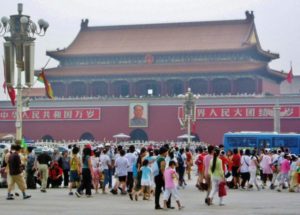
What to see in Forbidden City
1.- Tiananmen Gate
This beautiful and impressive building with the characteristic Chinese architectural style was built in 1420.
Mainly it was used for the great ceremonies of proclamation of the new emperor, which was communicated to the Chinese people from its superior tribune.
Until 1911, no one could cross the access door to the Imperial Palace , except for the family of the emperor and the aristocrats; hence the name of the Forbidden City .
Access to the Tiananmen Gate from the great square of the same name is done through five bridges of great beauty that cross the moat that surrounds the Imperial Palace.
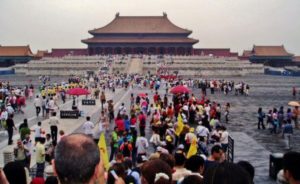
The Tiananmen gate also has a great symbolic meaning for the present-day China, since from the upper tribune that stands on the arch of the door was proclaimed in 1949 the People’s Republic by Mao Zedong .
Currently, a large portrait of the great leader Mao Zedong is located on the arch of the Tiananmen Gate .
2.- Halls of Harmony in Forbidden City
After entering through the Tiananmen gate , the most usual is to tour the Imperial Palace in the south-north direction through new doors and visiting the rooms that we are meeting as we go.
In fact they are small palaces with large rooms where certain activities were developed during their peak.
In times of much tourism , such as the month of August, doing this tour can mean going along with a real human tide of tourists, the absolute majority of Chinese origin.
The first door we will cross will be the Gate of Supreme Harmony , after which we will find ourselves in an impressive courtyard and in front of us.

And before us appears the first of the three rooms of Harmony , the so-called Hall of Supreme Harmony .
It is in this large courtyard of 30,000 square meters where the emperor made the great public ceremonies, standing at the door of the aforementioned Hall of Supreme Harmony .
The image of this Hall (or small palace) and a sample of this type of ceremony is presented in the film The Last Emperor , which was shot in the Forbidden City .
When a new emperor came to the throne, on his birthday or wedding, on the winter solstice or the Chinese New Year , these were some of the moments when these celebrations were held.
Built in 1406, the Salon de la Suprema Armonia has its location on a three-level white marble terrace, with balustrades decorated with numerous reliefs.
It was the symbol of imperial power, and during the era of the Ming and Qindynasties the construction of a larger building was not allowed.
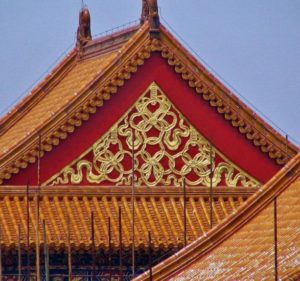
Following the Hall of Supreme Harmony , and located on the same elevated terrace, the Central Harmony Hall and the Hall of Preserved Harmony follow one another immediately .
The set of these three rooms occupies the main space of the Forbidden City, and for its decorations and layout is where we will find the best views inside the Imperial Palace.
In the Hall of Central Harmony , smaller than the other two, it was where religious ceremonies were usually held .
And in the Hall of Preserved Harmony was where the big banquets used to be held .
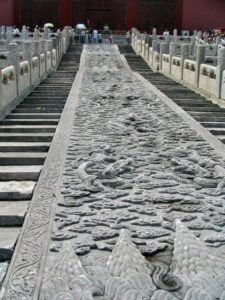
3.- Great Marble Stairway
One of the most amazing and beautiful corners that we can find in the Forbidden City is the great marble staircase .
Its great beauty and majesty makes it one of the most photographed places for those who have the opportunity to visit the Forbidden City.
Located at the back of the Hall of Preserved Harmony , it is a marble staircase in whose central part the figures of nine dragons have been sculpted.
Built during the Ming Dynasty , the grand staircase is 16.5 meters long, three meters wide and one and a half meters thick.
For its construction, a large marble stone was brought from a quarry located 70 kilometers from Beijing.
As a curiosity I will tell you that your transportation required the work during one month of 20,000 workers and thousands of mules.
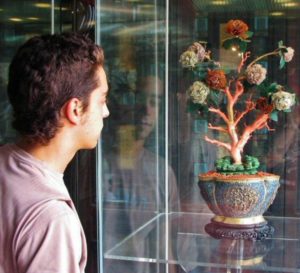
4.- Jewelry and jade objects in Hall of Longevity
While most of the furniture, jewelry and decorative elements that were in the Imperial Palace in Beijing were destroyed at different stages of Chinese history, in the Forbidden City are exhibited some pieces that have been preserved.
It is in the so-called Hall of Longevity , and in another contiguous, where you can see different decorative elements, such as the very beautiful decorative objects of jade , or various gold and silver jewelry .
Actually it is a small museum that contains the most outstanding artistic objects that you can see in the Forbidden City .
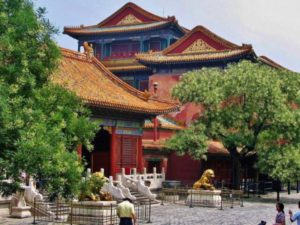
5.- Hall of the Mental Cultivation
This small palace known as the Mental Cultivation Hall has a special importance in the history of the Forbidden City of Beijing.
Built during the Ming dynasty , this palace was where the emperor himself had his office , and from the same ruled the Empire of China .
In addition, inside it also had a bedroom.
In fact, the Hall of the Mental Cultivation was the stay where three of the emperors of the history of China passed away.

And likewise, on February 12, 1912, in the Hall of the Mental Cultivation was where the last emperor of China signed his abdication before the new rulers coming from the Great Chinese Revolution .
The last government meeting of the Emperor of China took place there , although the imperial family was allowed to continue residing in the Forbidden City until it was expelled from the Imperial Palace in 1924.
In the aforementioned film The Last Emperor , this last stage of the Chinese empire is perfectly shown. It is a film that I recommend you do not miss if you have not seen it yet.
During your visit to the Imperial Palace , taking into account the enormous surface that occupies the palatial complex, you should not miss this room because it is one of the most attractive, so it is worth trying to locate it among all the pavilions there.

6.- Yuhuayuan Imperial Garden
Located near the northern gate, known as the Gate of Divine Power , the Imperial Garden (Yuhuayuan) occupies 12,000 square meters and was built in the days of the Ming Dynasty in 1417.
It has the characteristics typical of the typical Chinese garden, with trees, rocky areas, flower beds and sculptural elements, such as large bronze incense burners.
In the Imperial Garden of the Forbidden City there are more than twenty structures, and the main one is the Imperial Peace Hall .
To emphasize also a pine of more than 400 years, that symbolizes the harmony between the emperor and the empress.
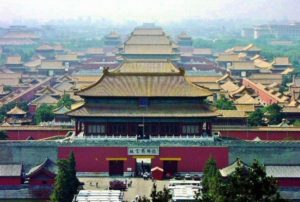
7.- Jingshan Park
In front of the exit of the Gate of Divine Power you will find a hill known as Jingshan Park ,
If you climb to the top of it you can have the best panoramic views of the Forbidden City .
The Jingshan Park actually covers an artificial hill just 47 meters, which was erected during the Ming Dynasty.
The Chinese tradition marked that the imperial palaces had to be constructed to the south of a hill, but when Peking happened to be the capital of China , in the location of the new imperial palace there was not a nearby hill, reason why it was raised artificially.
The hill is popularly known as Feng Shui .
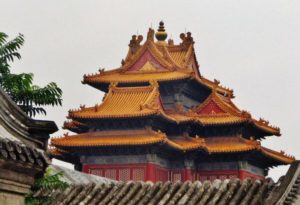
The Jingshan Park has more than 200,000 square meters of extension, and it has five peaks and in each of them a pavilion has been erected.
To access these pavilions and walk through the park there are several trails.
From the largest of these pavilions is where you can have the only panoramic views of the Forbidden City from the height, yes, if the frequent haze of the city of Beijing allows it.
Also, during your tour of the interior of the Forbidden City you can see to the north the great pavilion of Jingshan Park .
 Countries To Travel Travel Tips and Plans
Countries To Travel Travel Tips and Plans


